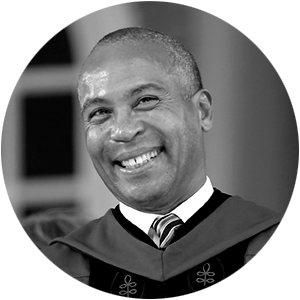For a candidate who never made it out of the low single digits, Marianne Williamson’s campaign still managed to go through all the cycles afforded to a major candidate: Media fascination, backlash, backlash to the backlash, backlash to the backlash to the backlash, and finally exit, on Friday.
Williamson, a lifestyle guru and author, had run for office once before she announced her presidential candidacy. That 2014 U.S. House run was a flop—she finished fourth in a large field. Expectations for her presidential campaign were, accordingly, not high.
But Williamson was an interesting character, so she got a decent amount of attention. Then there was backlash to those puffy stories, with Williamson being labeled a Democratic Trump (a big stretch by any measure, though Trump’s election was a warning about the dangers of electing people without any political experience).
Then came the counter-backlash: Make fun of Williamson’s woo-woo vibe all you want, but wasn’t her focus on healing a welcome counterweight to both Trump and the rest of the Democratic field? Plus there was that lovely, if entirely unplaceable, accent on the debate stage. The peak of this cycle came with a sympathetic profile by the profiler par excellence of the moment, Taffy Brodesser-Akner, in The New York Times Magazine, which pointed out that Williamson doesn’t even use crystals, dammit, and asked whether she was being ignored as a serious candidate, suggesting she might be another victim of sexism, like Hillary Clinton in 2016.
Then came the backlash to this backlash to this backlash: No, of course Williamson wasn’t a serious candidate, the political press said. By and large, the public seems to have agreed. Once the requirements to quality for debates stiffened, Williamson and her transatlantic drawl disappeared from the stage and largely from public view. Last week, she laid off her entire campaign staff but said he was soldiering on, but on January 10, she pulled the plug.
It’s no use seeking grand lessons about Williamson’s campaign. She was a long shot and she lost, like most long shots. But here’s something: It was nice to have an eccentric candidate who wasn’t a wild-eyed racist, a metric-stanning failson, or a serial sexual-harasser, like some of the long shots of recent cycles. With the glaring exception of her equivocation on vaccines, Williamson was mostly a nice person who was never going to be president. And if that provided a little bit of pleasure and positivity during an otherwise bleak slog of a primary, doesn’t that count as a victory for her vision?
Speaking of fringe candidates, Tom Steyer has been largely regarded as a joke (as below), an irritant (by many a debate watcher confounded by his presence), or an affront (by the faltering Democratic candidates who don’t have his deep pockets, and their supporters).
Is it time to regard Steyer as a serious candidate now? With strong showings in Nevada and South Carolina in a Fox News poll released yesterday, Steyer made it just under the wire for today’s deadline to qualify for the January 14 Democratic debate, in Iowa. That means he’ll be the sixth candidate onstage, and easily the least prominent—after Joe Biden, Bernie Sanders, Elizabeth Warren, Pete Buttigieg, and Amy Klobuchar.
Steyer’s unexpected presence is a tribute to finding two loopholes. The first is the qualifications for the debate stage, which require that candidates poll at 5 percent in four national polls or 7 percent in two early-state polls (in addition to meeting donor requirements). Steyer is nowhere near the first, but he nailed the second. If you’re looking to see Steyer’s progress on, say, RealClearPolitics’ poll average, then good luck. He’s muddled in the spaghetti mess of also-rans at the bottom of the chart, at 2.2 percent nationally—nestled between Tulsi Gabbard and Cory Booker.
The most likely explanation for how he pulled it off points to the second loophole: Steyer is really, really rich. That’s allowed him to buy a huge number of television advertisements, part of the nearly $50 million of his own money he’d spent by the end of September, the last time he reported. The New York Times’ Nate Cohn writes, “The explanation for Mr. Steyer’s surge is straightforward: uncontested dominance of the airwaves. According to FiveThirtyEight’s ad spending tracker, he has spent more on television advertisements than all other candidates combined—with the exception of the other billionaire in the race, Michael Bloomberg.” Steyer’s rivals contend that what the billionaire has really done is buy his way onto the debate stage—and with that, has shown how distressingly for sale American politics is.
It’s early to declare Steyer a real contender; the correct time to do that is still probably never. Though the Fox News poll, as Cohn notes, is a high-quality one (no matter what the president says), there isn’t much polling at the state level, so it’s hard to know quite what’s going on with Steyer’s popularity. Moreover, he remains a distant afterthought nationally. Getting on the debate stage will afford him a chance to build more momentum and gain followers, though he hasn’t been an especially effective debater so far.
Perhaps the most interesting lesson of the Steyer surge is for Michael Bloomberg. If one largely unlikable, aging billionaire can see this kind of payoff for advertising, why not another? Bloomberg isn’t bothering to try to qualify for the debates, saying that it would be inappropriate for someone of his wealth to ask for donations, and that therefore he can’t qualify. But he is vowing to pour massive amounts of money into the race. This week, he announced plans to drop $10 million on a Super Bowl ad, which then inspired President Donald Trump to do the same.
While Steyer’s national polling remains negligible, Bloomberg is now up to 5.5 percent on RCP, placing him ahead of Andrew Yang and Klobuchar, and not far behind Buttigieg—whose early-state polling has been good but whose national stature remains relatively small.
Progressives have for years demanded campaign-finance reform, and have insisted that democracy is not for sale. The fate of the Steyer and Bloomberg campaigns will show whether the Democratic Party nomination is, however, for sale.
As the primaries progress, this cheat sheet will be updated regularly.
The Democrats
MICHAEL BLOOMBERG
Who is he?
The billionaire former mayor of New York, Bloomberg is a Democrat turned Republican turned independent turned Democrat again.
Is he running?
Yes. Having ruled out a run in March, hizzoner changed his mind in early November and officially launched his campaign on November 24.
Why does he want to run?
For starters, he is convinced that he’d be better and more competent at the job than anyone else. Bloomberg’s bid will likely center on his pet issues of gun control, climate change, and fighting the more fiscally liberal wing of the Democratic Party tooth and silver-plated nail.
Who wants him to run?
What, is his considerable ego not enough? Though his tenure as mayor is generally well regarded, it’s unclear what Bloomberg’s Democratic constituency is beyond other wealthy, socially liberal, and fiscally conservative types, and it’s not as if he needs their money to run.
Can he win the nomination?
Probably not. Bloomberg previously toyed with an independent run, but said that would only help Trump in 2020.
DEVAL PATRICK
Who is he?
Patrick was governor of Massachusetts from 2007 to 2015, after serving in a top role in Bill Clinton’s Justice Department. More recently, he’s worked at Bain Capital.
Is he running?
Yes. Patrick officially entered the race on November 14.
Why does he want to run?
To be president, of course. But having passed on a run earlier, Patrick reconsidered because of worries that no one in the Democratic field has strong momentum and can unite the party.
Who wants him to run?
There’s an appetite for new candidates among some in the Democratic donor class, though there’s little sign that voters are so eager. Patrick is close to Barack Obama, but the former president has stayed out of the primary.
Can he win?
We’re not saying that a former Massachusetts governor and Bain employee can’t win the presidency, but recent history isn’t encouraging. But take it from Patrick: “I recognize running for president is a Hail Mary under any circumstances. This is a Hail Mary from two stadiums over.”
What else do we know?
Patrick’s estranged father played in the alien jazz great Sun Ra’s Arkestra.
TOM STEYER
Who is he?
A retired California hedge-funder, Steyer has poured his fortune into political advocacy on climate change and flirted with running for office.
Is he running?No. He announced on January 9 that he would sit the race out. Lol jk! Steyer decided to get back into the race on July 9 after all.
Why does he want to run?
Impeachment, baby.
Who wants him to run?
There must be some #Resistance faction out there that does.
Can he win the nomination?
Nope.
MICHAEL BENNET
Who is he?
The Coloradan was appointed to the Senate in 2009 and has since won reelection twice.
Is he running?
Yes. Bennet announced his campaign on May 2.
Why does he want to run?
Like his fellow Rocky Mountain State Democrat John Hickenlooper, Bennet presents himself as someone with experience in business and management who knows how to work with Republicans.
Who wants him to run?
Probably some of the same people who wanted Hickenlooper to run. Bennet gained new fans with a viral video of his impassioned rant about Ted Cruz during the January government shutdown.
Can he win?
No.
Source link
 Black America Breaking News for the African American Community
Black America Breaking News for the African American Community



